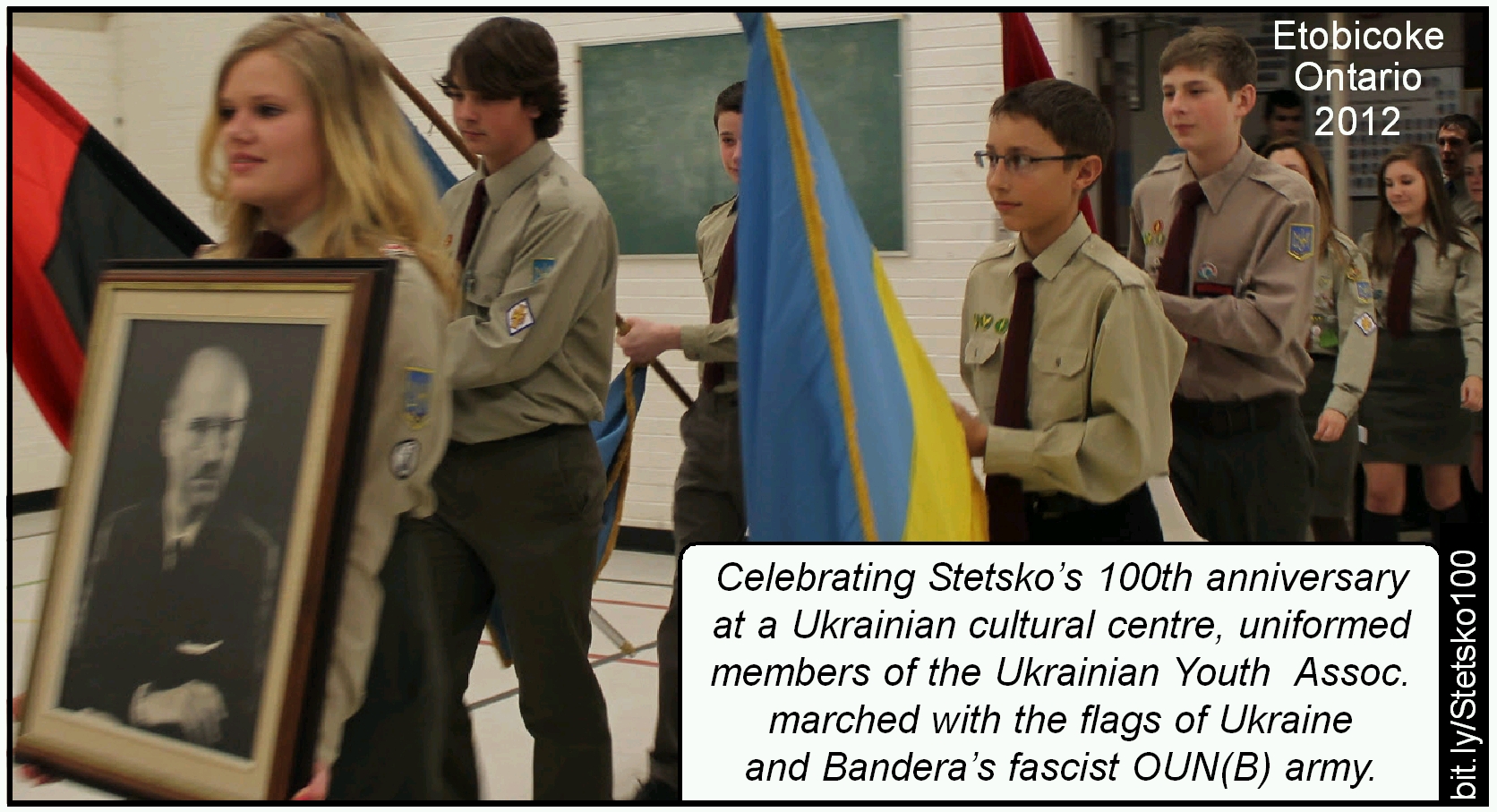|
Magazine
Contact
Facebook
Subscribe/Donate
ArmsShows
Media
Myths
CPP
SlideShows
AirShows
Issue #70,
Press for Conversion! (Spring 2021)
Please subscribe,
order print copies or make a donation to support this work: |
|
|
Defunding Cold War Canada Table of Contents Canada’s anti-Red, Cold War
propaganda in context |
Summary article This new article summarizes the largely-hidden history of government collaboration with fascist-linked East European émigré groups in Canada. This history is documented in a 64-page report in Press for Conversion! magazine, Spring 2021. This report is now online here or by clicking the links at left, or in the article below. Please share widely. Thanks! By Richard Sanders The Canadian government has long supported East European émigré associations whose much-revered founders, leaders and war heroes include veterans of Waffen SS divisions and other fascist military formations, perpetrators of the Holocaust and other ethnic-cleansing campaigns, officials from and apologists for Nazi puppet regimes, postwar CIA propaganda assets, proponents of Cold War terrorist groups like the US-armed Nicaraguan contras and Afghan mujahideen, and other virulently anticommunist "freedom fighters" and their ideologues. Over the past few years alone, the most influential of these ethnonationalist émigré organizations -- those representing the rightwing Ukrainian diaspora -- have received millions of dollars in Canadian government grants and contributions. For many decades, the Canadian government's financial largesse has helped subsidize the most powerful of these groups' day-to-day operations, their office spaces, meeting halls, events and publications. In doing so the Canadian government continues to aid and abet these associations' efforts to glorify, with cult-like adoration, their fascist heroes from WWII and the Cold War. (Read articles with Details on Canadian Government Funding) Throughout the Cold War, Canada's rightwing émigré groups—such as those representing Czechs, Estonians, Latvians, Lithuanians, Poles, Slovaks and Ukrainians—were enthusiastic cheerleaders for the Canadian government's devotion to proUS and proNATO policies. Their ongoing support for Canada's hawkish foreign policies has not wavered. Long recognized by Canada's government as officially representing their ethnic communities, these émigré organizations continue to promote propaganda narratives that whitewash their histories. These histories would be publicly embarrassing to them and to their government allies if the mass media were ever to expose them. However, the corporate press has itself been deeply complicit in perpetuating the very propaganda that still needs to be exposed. Canada's ethnonationalist organizations continue to push their political agendas by initiating and assisting rightwing government policies that suit their shared goals. They also serve government interests by mobilizing electoral support from their ethnic communities and the public at large for mainstream politicians, their parties and corporate-friendly programs. |
Exposing the fascist roots of Canada's Cold War émigrés from Eastern EuropeBefore and during WWII, the Canadian government's firmly entrenched immigration policy was to turn away Jewish and leftwing refugees who were desperately trying to flee persecution by the Nazis and other fascist forces in Europe. Then, during the late 1940s and early 1950s—with the West's launch of its Cold War against communism and the USSR—Canadian governments continued to restrict the immigration of Jews, communists and others considered undesirable. In stark contrast, these Liberal governments eagerly encouraged the entry of about 160,000 predominantly antiSoviet migrants from Eastern Europe. Although many of these newcomers either collaborated with Germany's Nazis and their East European allies, or at least shared their extreme antiRed/antisemitic worldviews, the government and its friends in the mainstream media considered them to be virtually ideal Canadians.
These Nazi
sympathizers who were welcomed here by Canada's early Cold War Liberal
governments, included thousands of veterans of Baltic and Ukrainian Waffen
SS divisions, as well as fighters from East Europe's clandestine guerrilla
armies. The latter were fascist militias brought together with Nazi
support in November 1943 by Stepan Bandera's faction of the Organization
of Ukrainian Nationalists (OUN-B). This alliance of antisemitic/anticommunist
armies called themselves the Committee of Subjugated Nations. In 1946,
with funding from US, UK and West German intelligence agencies, this OUN(B)-led
network rebranded themselves the AntiBolshevik Bloc of Nations (ABN).
For the next half
century, the
ABN remained the most powerful network of antiSoviet groups led by former
Nazi collaborators. They continued their wartime Russophobic struggle
under the protection of new, Cold War benefactors, who had taken over
Hitler's role as the world's leading force for anticommunism. While openly
advocating armed struggle by all of the so-called "subjugated," "enslaved"
and "captive nations" still trapped behind the "Iron Curtain," the ABN
fought a propaganda war to pursue their longstanding goal, the utter
destruction of the Soviet Union. Headquartered in Berlin, and dominated by
Ukrainian fascist organizations led by Bandera and his deputy Yaroslav
Stetsko, the ABN's base of support relied on the extremely anticommunist
ethnic organizations that emerged to represent those displaced East
European communities in postwar Germany and elsewhere. In the immediate aftermath of the war, these communities understandably sought to escape the consequences of their collaboration with the Nazis. While they still pretend to have been equally opposed to Germany and the USSR, these extreme anticommunists and their sympathizers fought repatriation to the Soviet Union. Considering themselves to be "freedom fighters" who had waged the war's noble crusade against Soviet communism, these veterans, their families and highly-supportive communities, were generously given refuge in Canada. Once embraced and protected in this multicultural country, some of the most strident of these anticommunists soon became the founders and leaders of major ethnonationalist associations. These highly-politicised anticommunist groups still represent Canada's largest East European diaspora communities.
Canada's web of "captive nations" groups in the
|
Toronto:
|
Throughout the Cold War, Canada's "captive nations" organizations banded together to form alliances that lobbied the government and pushed their political agendas through the corporate-controlled, mass media. These Canadian networks have included the Canadian branch of the ABN, the Baltic Federation of Canada, and the Black Ribbon Day Committee which in the mid1980s took over from the Group of Seven (a.k.a. Canada's Committee of Captive European Nations). The current iteration in this evolution of far-right networks is the Central and Eastern European Council in Canada. It represents the same seven cultural diasporas that came together for anticommunist propaganda offensives during the Cold War. Its member organizations now find unity in focusing their wrath on Russia, whitewashing their WWII histories, and falsely portraying fascism and communism as diabolical, twin evils that launched that war.
The Cold War efforts of Canada's Committee of Captive European Nations with the psychological warfare campaigns of the US-based Assembly of Captive European Nations. This US-based alliance, created in 1954, was funded for decades by the National Committee for a Free Europe, a covert CIA front organization chaired by Allen Dulles (CIA Director, 1953-61). Canada's ultranationalist émigrés worked closely with their US allies as well as with other counterparts around the world, particularly in western Europe, Australia and South America, where similar communities of fascist collaborators had relocated after the war.
While Western intelligence agencies backed these representatives of the widely-scattered East European diaspora, NATO governments bestowed their leaders with artificial authority by granting them official recognition as "governments in exile." Canada, being one of the largest recipients of this exodus, had its share of these international leaders.
Throughout the Cold War, the efforts of these and other far-right East European groups around the world were promoted by the CIA's huge propaganda apparatus. Chief among these were Radio Free Europe and Radio Liberty (RFE/RL). (RL originally operated under the name Radio Liberation from Bolshevism.) Although now privatised and largely funded by George Soros' Freedom Foundation, these CIA media outlets gave voice to numerous former Nazi collaborators. The CIA website still brags that the RFE/RL was one of their greatest success stories, and credits it with having played a key role in destroying the Soviet Union. From its early heyday in the 1950s, RFE/RL was ostensibly funded by "Crusade for Freedom." This major CIA propaganda campaign was publicly fronted by then-actor and corporate shill, Ronald Reagan.
Cozying up to collaborators: A Liberal-Tory competition in anticommunism
Canada's Liberal governments under Prime Ministers Mackenzie King, Louis St Laurent and Lester Pearson were eager to promote Western civilization by participating in the US-led, NATO war against communism. Pearson in fact saw his co-founding of NATO, as his biggest contribution to world peace. Under his tutelage, Canada worked most aggressively to wage a total war against communism. This multifaceted military, political, economic, cultural, ideological and spiritual battle targeted what Pearson deemed to be an insidious evil to be eradicated both at home and abroad. Although still heralded as an icon of peace by many, Pearson brought the social phobia of extreme anticommunism to dizzying heights. As such, Pearson should be recognised as a political godfather of the Cold War and the heroic patriarch of its hate-filled propaganda.
Pearson's many
contributions to this elitist cause included threatening leftwing
"ban-the-bomb" peace activists with treason, purging leftists from the
civil service and creating CBC International, a propaganda arm of the
Department of External Affairs that beamed incessant right-wing propaganda
in various languages around the world. But for many decades, the main
targets of these Voice-of-Canada broadcasts, were citizens of the Soviet
Union and its East European allies. To fight this psychological
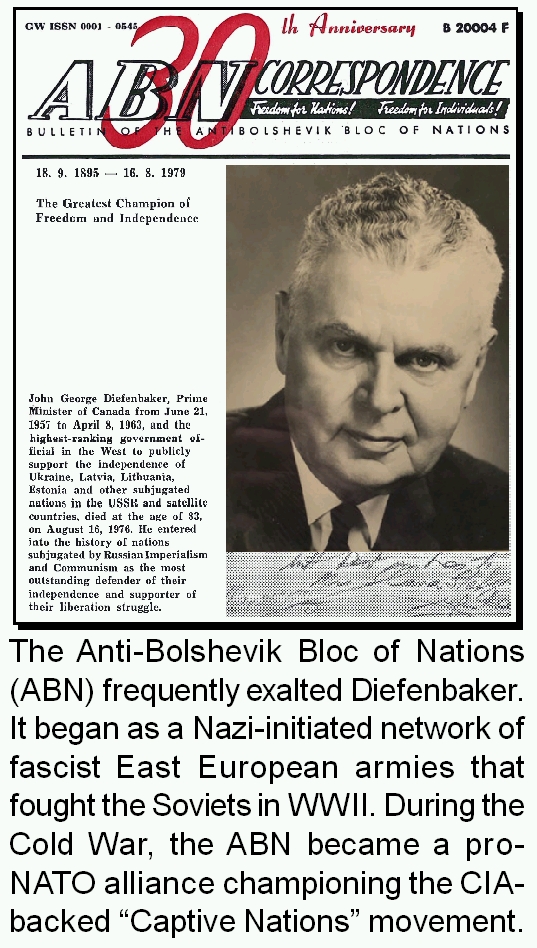 war,
Pearson and his colleagues worked closely with the leadership of Canada's
far-right East European émigré groups.
war,
Pearson and his colleagues worked closely with the leadership of Canada's
far-right East European émigré groups.
(See: "L.B.Pearson:
Godfather of Canada’s Cold War on the new "Red" enemy"
and "Wielding
CBC’s “Voice of Canada” as a weapon of Cold War propaganda")
But the Liberal Party was not alone in waging Canada's Cold War battles. In fact, the Liberal and Progressive Conservative parties engaged in a seeming competition to position themselves as Canada's political champions of NATO's anticommunist worldview. Both tried to outdo the other in their vitriolic attacks against their common Soviet foe; both bent over backwards to ingratiate themselves to Canada's self-styled "captive nations;" and both vied for these émigré communities' support during and between elections. (A similar jockeying process continues to this day as these, and other parliamentary parties, strive to tap into this diaspora's voter base as well as to demonize NATO's current, Kremlin-based enemies.)
To this day, Tory
Prime Minister John Diefenbaker is remembered with great fondness by East
European émigrés who remember his historic denunciation of the USSR at the
United Nations. In 1960, Diefenbaker took to the world stage at the UN and
led the way in decrying the Soviet Union. His inflammatory UN diatribe
came in response to the USSR's launch of a groundbreaking General Assembly
resolution that critiqued the imperialist powers for their racist,
colonial histories of war, slavery and corporate plunder. Khrushchev's UN
speech demanded complete emancipation of imperialism's colonial assets.
The Soviet initiative was well received throughout the world, especially
by socialist countries and the Non-Aligned Movement. While not one nation
voted against the USSR's resolution, eight imperialist powers and one
US-backed military dictatorship abstained. The Soviet initiative invoked
such outrage from Canada that for many decades Diefenbaker was exalted as
a great hero by the profascist ABN and its most reactionary East European
member groups in Canada.
(See: "John
Diefenbaker: Strong voice at the UN for 'Captive Nations' bloc")
The "Black Ribbon Day" (BRD) Crusade: Canada's greatest Cold War export
With tremendous support from the corporate media as well as from politicians ensconced at all levels of government, Canada's far-right East European diaspora played major roles in many of the Cold War's most successful propaganda crusades. The best ongoing example of this is the international Black Ribbon Day (BRD) movement which was spawned in the mid-1980s by leading activists in Canadian and international East European diaspora groups based in Toronto. The campaign was initiated by Markus Hess, a Canadian of German-Estonian heritage representing Canada’s Toronto-based Estonian Central Council.
After recruiting support from Canada’s Committee of Captive European Nations (i.e. the Toronto-based "Group of Seven"), they decided to broaden their core base of support beyond East European émigré groups by teaming up with the National Citizens’ Coalition (NCC). With 40,000 members, it was one of Canada’s most formidable, rightwing forces. NCC vice president David Somerville became what Hess calls his "brother in arms." While building the International BRD Committee, they toured Europe and met Slava Stetsko. She had just assumed top leadership positions in the ABN, the Banderite-led Organization of Ukrainian Nationalists (OUN-B), and the World AntiCommunist League (WACL) from her recently-deceased husband, Yaroslav Stetsko. (See photo above.)
Growing by leaps and bounds, the ABN campaign to obfuscate WWII history, quickly became Canada's greatest Cold War propaganda export. Still expanding, the BRD campaign continues to spread the hate-filled myth of fascist-communist equivalency by focusing on August 23, 1939, when the USSR very reluctantly signed a nonaggression treaty with Germany.
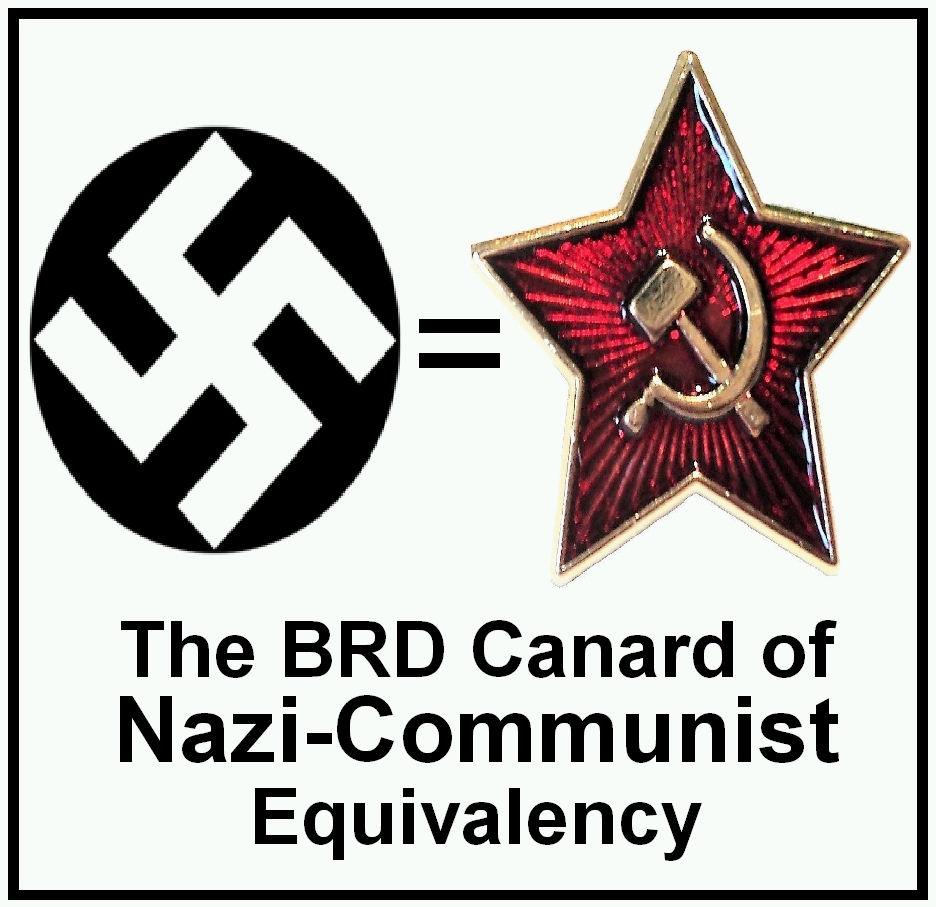 BRD
propaganda conveniently forgets that Nazism and communism are
diametrically opposed political forces. By 1939, the Soviets and
communists around the world had long been opposing the rise of fascism.
They had known of course for many years that Hitler's fanatical
anticommunism—expressed in Mein Kampf (1925)—included the dream of
expanding Germany by overtaking the USSR. In mid-August 1939, Soviet
leaders made a final last ditch effort to persuade Britain and France to
join them in a war to stop Nazi Germany. When they refused these Soviets
pleas to form a military alliance against the Nazis, the USSR felt
compelled to sign an agreement with Germany not to attack one another.
This gave the Soviets another 22 months to build their defences against
the Nazi invasion which they knew was coming. Without that time to
prepare, the Soviets would not have been able to withstand the Nazi
invasion that came in June 1941. In fact, because The USSR signed that
treaty, they were able to eventually defeat German forces in
Stalingrad and to
begin to expel them from all of Eastern Europe, thus liberating various
Nazi death camps, including Auschwitz.
BRD
propaganda conveniently forgets that Nazism and communism are
diametrically opposed political forces. By 1939, the Soviets and
communists around the world had long been opposing the rise of fascism.
They had known of course for many years that Hitler's fanatical
anticommunism—expressed in Mein Kampf (1925)—included the dream of
expanding Germany by overtaking the USSR. In mid-August 1939, Soviet
leaders made a final last ditch effort to persuade Britain and France to
join them in a war to stop Nazi Germany. When they refused these Soviets
pleas to form a military alliance against the Nazis, the USSR felt
compelled to sign an agreement with Germany not to attack one another.
This gave the Soviets another 22 months to build their defences against
the Nazi invasion which they knew was coming. Without that time to
prepare, the Soviets would not have been able to withstand the Nazi
invasion that came in June 1941. In fact, because The USSR signed that
treaty, they were able to eventually defeat German forces in
Stalingrad and to
begin to expel them from all of Eastern Europe, thus liberating various
Nazi death camps, including Auschwitz.
By 2009, Canada's BRD
crusade gained unanimous endorsement in parliament when presented by
Liberal MP Bob Rae, the former NDP premier of Ontario. (The bill was
drafted by an Estonian leader of the Central and Eastern European Council
in Canada, which spearheaded the parliamentary initiative.) That year, BRD
was also officially recognized by the US and Australian governments. Since
then, BRD laws—which deceitfully equate the world’s most avidly-opposed,
mortal enemies as if they were equally to blame for starting WWII—have
been passed in nine East European countries.
(See: "The
BRD campaign: Canada’s top Cold War propaganda export" and "The
late Cold War context of the BRD crusade")
Ukrainian ethnonationalism: Linchpin of the far-right "captive nations" movement
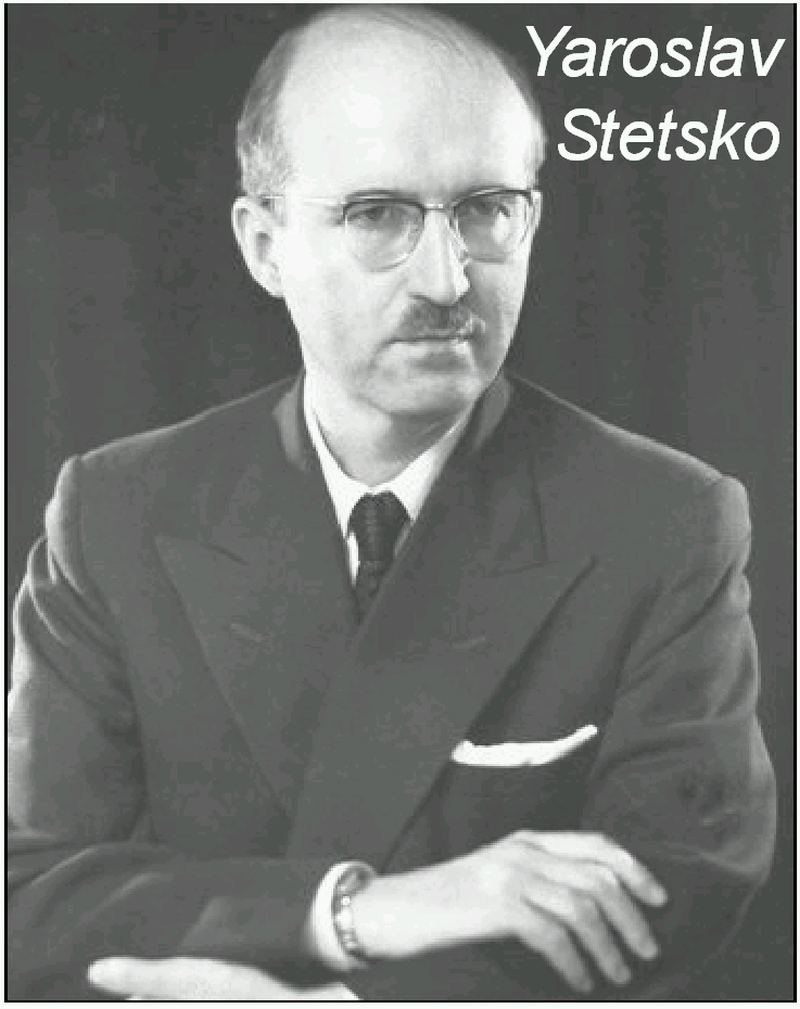 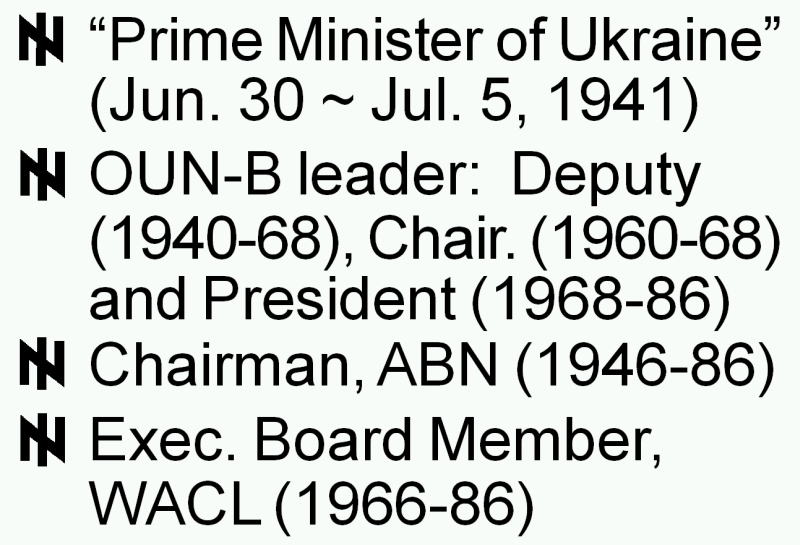 |
While governments in
Canada since WWII (both Liberal and Tory alike) employed their
McCarthyesque zeal to disempower progressive leftwing activists, the
country's far-right East European émigré groups enjoyed friendly relations
with leading politicians and received generous funding from the state.
Most notable among those benefiting from millions of dollars in recent
Canadian government grants, are Ukrainian groups that still glorify
WWII-era war criminals as their cultural heroes. These Ukrainian
associations still revere with cult-like devotion such leading fascist
ideologues and military leaders as Stepan Bandera, Yaroslav Stetsko and
Roman Shukhevych.
(See:
Roman Shukhevych: Assassin,
terrorist, ethnonationalist, war criminal and cult hero")
In June 1941, immediately following the German invasion of Soviet Ukraine, in which Shukhevych led the Nazi-collaborating Ukrainian Nachtigall Battalion, Stetsko was proclaimed to be the "Prime Minister" of a new Ukrainian state that pledged its allegiance to Germany.
Stetsko's biography
written July that year stated in part:
“I consider Marxism to be
a product of the Jewish mind, which has been applied in the Muscovite
prison of peoples by the Muscovite-Asiatic people with the assistance of
Jews. Moscow and Jewry are Ukraine’s greatest enemies and bearers of
corruptive Bolshevik international ideas. Although I consider Moscow,
which in fact held Ukraine in captivity, and not Jewry, to be the main and
decisive enemy, I nonetheless fully appreciate the undeniably harmful and
hostile role of the Jews, who are helping Moscow to enslave Ukraine. I
therefore support the destruction of the Jews and the expedience of
bringing German methods of exterminating Jewry to Ukraine, barring their
assimilation....” (Yaroslav
Stetsko, “My
Biography,” July
1941.
(See: "Yaroslav
Stetsko: Leader of proNazi Ukraine, 1941")
In Canada, the global
OUN-B movement is represented by the League of Ukrainian Canadians, which
officially represented the ABN in Canada. The strongest affiliate of this
government-funded organization is the quasi-military Ukrainian Youth
Association. Its purpose includes the indoctrination of children and
youth in this community's cultural tradition. As a scouting organization,
its uniform-clad Bandera youth, are taught to march in formation carrying
the battle flags of the OUN-B's Ukrainian Insurgent Army. They also
display a cult-like adoration for their community's Nazi-collaborating war
heroes by perform patriotic songs and dances flanked by large portraits of
their military leaders in government-funded Ukrainian community centres.
(See: "Government-funded
centres of Canada’s Bandera cult and its Bandera youth")
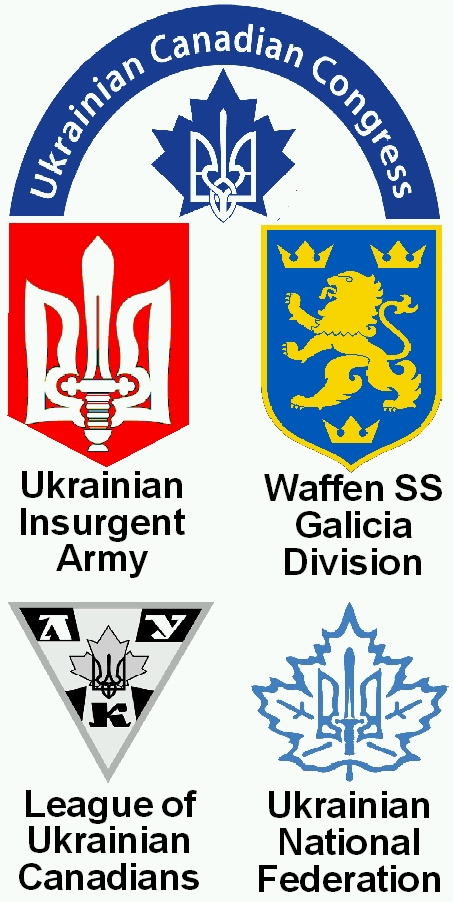 For
several decades, LUC officials have held the top leadership positions
within the Ukrainian Canadian Congress (UCC). This umbrella organization,
which falsely claims to represent all Ukrainians, was created by Mackenzie
King's infamously antisemitic Liberal government in 1940. Its purpose was
to unify anticommunist Ukrainian groups in support of government policies,
and to help them crush the anti-fascist Ukrainian organizations
which—although thoroughly despised and long persecuted by Canada's
government— then dominated the Ukrainian diaspora in Canada.
For
several decades, LUC officials have held the top leadership positions
within the Ukrainian Canadian Congress (UCC). This umbrella organization,
which falsely claims to represent all Ukrainians, was created by Mackenzie
King's infamously antisemitic Liberal government in 1940. Its purpose was
to unify anticommunist Ukrainian groups in support of government policies,
and to help them crush the anti-fascist Ukrainian organizations
which—although thoroughly despised and long persecuted by Canada's
government— then dominated the Ukrainian diaspora in Canada.
The UCC also brought together the OUN-B with its rival faction within the OUN. That faction, the OUN-M, led by Andriy Melnyk, was more trustworthy to the Nazis. As such it was instrumental in coordinating overall collaboration and establishing the Waffen SS Division, whose volunteers pledged to fight to the death for Hitler's antiBolshevik cause. The OUN-M is represented within the UCC by the Ukrainian National Federation of Canada.
Throughout the Cold
War and since, the UCC has continued to promote the proNATO/Russophobic
foreign policies that it shares with the Canadian government. Most
recently this has involved working closely with its strong allies in the
Harper and Trudeau governments to build corporate and military ties with
far-right, proNATO governments in Ukraine and to wage economic war against
their shared, Kremlin-based enemies.
(See: "Liberal
Canada’s Ukrainian Canadian Congress")
Closing the Pandora's Box:
Beyond the Freeland-Chomiak connection
Over the decades, Canada's state-funded "captive nations" groups—particularly those associated with the Ukrainian Canadian Congress and the League of Ukrainian Canadians—have seen considerable success helping to elect their confederates to public office. None however have come closer to power than under the Trudeau Liberals. Despite the flurry of news in 2017 revealing that Chrystia Freeland's maternal grandfather, Michael Chomiak, was the Nazi's top Ukrainian-language news propagandist throughout WWII, the mass media has remained silent on her own life-long history of involvement in fascist-linked Ukrainian organizations and their publications. To shed light on this story would reveal many additional skeletons in the still largely closeted histories of government and media involvement with Nazi collaborators.
Freeland can, of course, bear no blame for her grandfather's role in promoting and benefiting from Nazi war crimes. However, legitimate concerns have been raised about her efforts to deflect the truth by turning the blame on Russia. By decrying the revelations about Chomiak as a Kremlin-led smear campaign to undermine Canadian democracy, this PR tactic put a chill on further "unpatriotic" stories. Similar tactics were used throughout the Cold War by émigré groups when their founders, leaders or adherents were revealed to have been Nazi collaborators.
Still left uncovered by the mainstream media, are the facts about Freeland's three decades of support for Ukrainian-Canadian organizations with historic links to fascism.
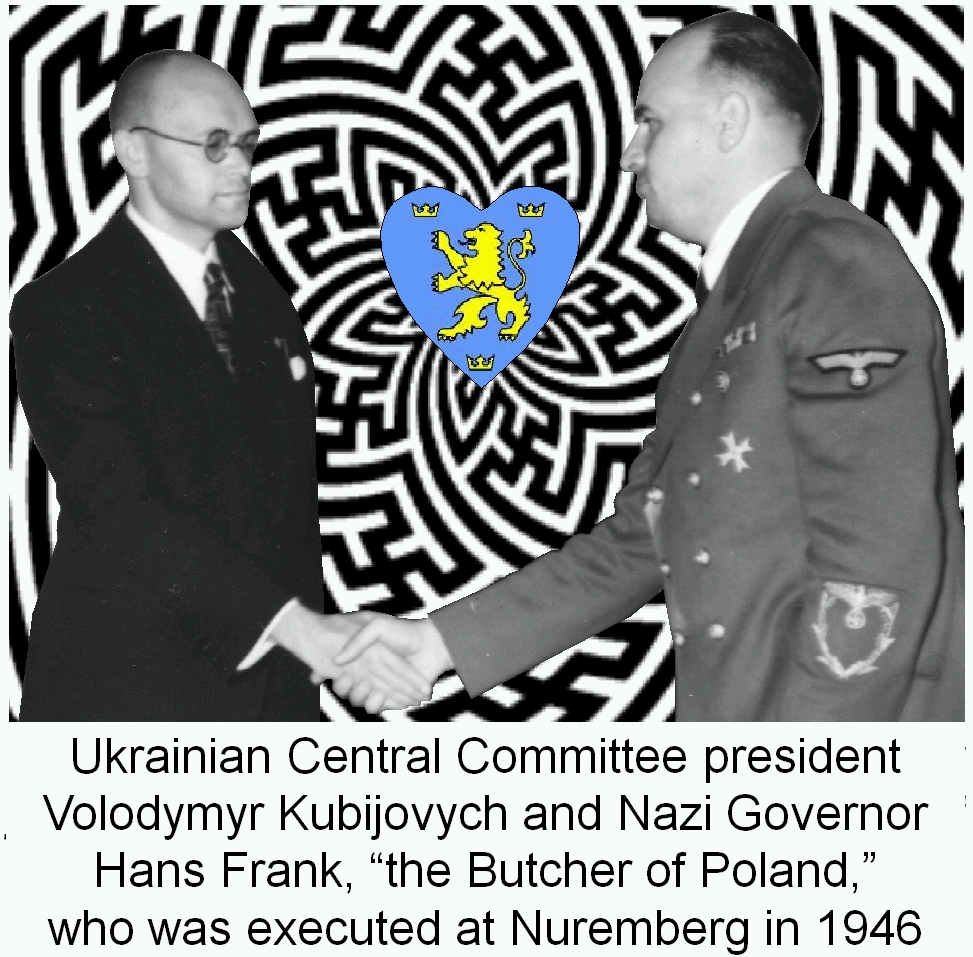 As
early as 1986, Freeland took her first Canadian government-funded job
writing for the Edmonton-based Encyclopedia of Ukraine. This
publication, in which her grandfather had been involved since at least
1976, was the brainchild of Volodomyr Kubijovych. He was Chomiak's boss
throughout WWII and led the Ukrainian Central Committee. Representing
Melnyk's faction of the OUN, it was established and funded by the German
military's Abwehr intelligence agency to oversee Ukrainian
collaboration with the Third Reich. This included Chomiak's career as a
Nazi propagandist who recruited for the Ukrainian Waffen SS Galicia.
As
early as 1986, Freeland took her first Canadian government-funded job
writing for the Edmonton-based Encyclopedia of Ukraine. This
publication, in which her grandfather had been involved since at least
1976, was the brainchild of Volodomyr Kubijovych. He was Chomiak's boss
throughout WWII and led the Ukrainian Central Committee. Representing
Melnyk's faction of the OUN, it was established and funded by the German
military's Abwehr intelligence agency to oversee Ukrainian
collaboration with the Third Reich. This included Chomiak's career as a
Nazi propagandist who recruited for the Ukrainian Waffen SS Galicia.
(See: "Nazi
Germany’s Ukrainian Central Committee")
After the war, Kubijovych's encyclopedia became an all-consuming effort to consolidate an official, whitewashed version of history. In 1976, Kubijovych travelled from France to Edmonton where he signed a deal to team up with the provincially-funded Canadian Institute for Ukrainian Studies (CIUS) at the University of Alberta. One CIUS co-signer was Peter Savaryn, a proud veteran of the Ukrainian SS. A decade later, when Freeland first job for the encyclopedia began, and it's publication was still the CIUS's top project, Savaryn was the university's chancellor.
 In
the late 1980s, Freeland also worked for another Edmonton-based
publication in which her grandfather had been involved, The Ukrainian
News. Exemplifying the Melnykite brand of ethnonationalism, it pushed
the Cold War's hyperbolic anticommunism, and was edited by Freeland's
grandfather in the early 1980s.
In
the late 1980s, Freeland also worked for another Edmonton-based
publication in which her grandfather had been involved, The Ukrainian
News. Exemplifying the Melnykite brand of ethnonationalism, it pushed
the Cold War's hyperbolic anticommunism, and was edited by Freeland's
grandfather in the early 1980s.
Her early media career also included co-authoring an antiSoviet article in
1988 for The Ukrainian Weekly, America's largest Ukrainian
publication. To understand this paper's political orientation, it is worth
noting that her article appeared on the same page as an ad for a book that
glorified the Nazi-armed, -funded and -led Ukrainian SS as noble "freedom
fighters."
Freeland also contributed to that former CIA propaganda front, Radio
Liberty (RL), through a 1990 interview with the founder of Rukh, Ukraine’s
separatist movement. This RL interview, done at the CIUS, was printed in
The Ukrainian Weekly, as well as in an RFE/RL-published journal,
and an RFE/RL-published book.
Freeland's fledgling media work for publications deeply rooted in
Ukrainian fascism and the CIA, coincided with her work as a grassroots
activist fighting for Ukrainian independence from the USSR. As a young
Canadian activist in Soviet Ukraine, within a CIUS student exchange
program, Freeland became so deeply engaged in influencing Ukrainian
elections that she was publicly denounced by the government there as a
"well-known troublemaker" and a "banderite enemy of the Soviet state."
While the Soviet government lodged an official complaint to the Canadian
embassy denouncing her meddling in Soviet elections, Freeland was exalted
as a hero by Canada's corporate press. Using the credentials afforded by
her proven commitment to the Cold War's extremely antiSoviet biases,
Freeland used her new-found celebrity to launch a career in mainstream
journalism.
This move coincided with her so-called "chance meeting" with billionaire
George Soros. Freeland says she met Soros in Soviet Ukraine and advised
him on anticommunist dissident groups and individuals that deserved his
financing. Having gladly assisted his early efforts to influence Soviet
politics, Freeland began a friendly working relationship with Soros which
has continued for decades.
Freeland's inability to be objective on political issues was not a liability for her aspiring career. In fact, her devotion to anticommunism must have been an important asset contributing to her meteoric rise through the corporate ranks to became an information gatekeeper for the Financial Times' (Moscow bureau chief) and The Globe and Mail (deputy editor).
Given Freeland's
continuing identification with her far-right Ukrainian community, and the
government’s continuing support for the hawkishly Russophobic diaspora,
Canadians would be prudent to heed their government’s increasingly
bellicose, proUS/proNATO foreign policies. For example, during her tenure
as foreign minister, Canada took a prominent role in US-led efforts to
provoke a coup against the democratically-elected socialist government of
Venezuela.
 Freeland
has also continued to maintain affectionate working relationships with her
good friends and allies in Ukrainian-Canadian organizations with fascist
roots. For example, in 2015, she tweeted a photo of herself with the three
leading elder statesmen of Canada's Banderite movement: Oleh Romanyshyn,
Yuri Shymko and Orest Steciw. These men have devoted their lives to
serving as major organizers, spokesmen and leaders for such groups as the
League of Ukrainian Canadians, its Ukrainian Youth Association, the AntiBolshevik Bloc of Nations and the Ukrainian Canadian Congress.
Freeland
has also continued to maintain affectionate working relationships with her
good friends and allies in Ukrainian-Canadian organizations with fascist
roots. For example, in 2015, she tweeted a photo of herself with the three
leading elder statesmen of Canada's Banderite movement: Oleh Romanyshyn,
Yuri Shymko and Orest Steciw. These men have devoted their lives to
serving as major organizers, spokesmen and leaders for such groups as the
League of Ukrainian Canadians, its Ukrainian Youth Association, the AntiBolshevik Bloc of Nations and the Ukrainian Canadian Congress.
(See: "Yuri
Shymko: From Bandera youth leader, MPP and MP, to elder statesman")
Our struggle continues...
Following its long history of hate crimes,
war, imperial land plunder and genocide against First Nations, the
Government of Canada has officially proclaimed its intent to follow a
process of truth and reconciliation. Canada's very foundations are
grounded in this genocide that was based on an ethnonationalist,
white-power elitism that declared the supremacy of European culture and
its economic, legal, political and religious institutions. Unfortunately,
the government has failed to follow through even with the calls for action
outlined by the Truth and Reconciliation Commission.
More recently, the Trudeau Liberals have said that they will end the Canadian
government's long, ongoing legacy of systemic racism. Don't hold your
breath on that promise either...
Because Nazi Germany and its fascist allies
exemplify racism in a most extreme form, the Canadian government needs to
acknowledge and be held accountable for its Cold War collaboration with
East European émigré organizations linked to perpetrators of the Holocaust and
other crimes against peace and crimes against humanity committed against
our allies during WWII.
For a start, the
Canadian government should account for its Cold War policy of supporting
and collaborating
with East European ethnonationalist groups whose virulently anticommunist
founders, leaders and war heroes include those who promoted and/or took part
in ethnic cleansing campaigns and the mass murder of their political enemies on the
left.
At the very least, the Government of Canada should stop its decades-long
funding of ethnonationalist, émigré associations that continue to
whitewash, revere and glorify WWII leaders and their fascist
organizations, movements and military formations. These associations,
which officially represent the East European diaspora in Canada, were
originally founded, led and supported by Nazi sympathizers and
collaborators, veterans of Waffen SS divisions as well as members of other
fascist military units that helped to perpetrate the Holocaust and other
genocidal, ethnic- and political-cleansing campaigns.
Over the past few years alone, the most influential of these organizations
-- representing Canada's far-right Ukrainian diaspora -- have received
millions of dollars in government support.
It is long overdue for Canadians to demand that their government stop this financial assistance which for decades has been helping to subsidize these groups' day-to-day operations, their office spaces, meeting halls, events, publications and propaganda campaigns.
By discontinuing this financial assistance, the government can begin the process of ending its systemic Cold-War collaboration with organizations that are deeply rooted in fascist history and which continue to proudly defend and glorify their so-called "freedom fighting," WWII-era heroes.
A first step in this process is to make this ongoing history better known to Canadians. Please do whatever you can to help.
![]() Share this summary article on
FACEBOOK
Share this summary article on
FACEBOOK
Coalition to Oppose the Arms Trade
To receive a free sample copy of Cold War Canada in the mail, send your Canadian street address to:
overcoat@rogers.com
Coalition to Oppose the Arms Trade Contact Facebook Support ArmsShows Media Myths CPP SlideShows AirShows
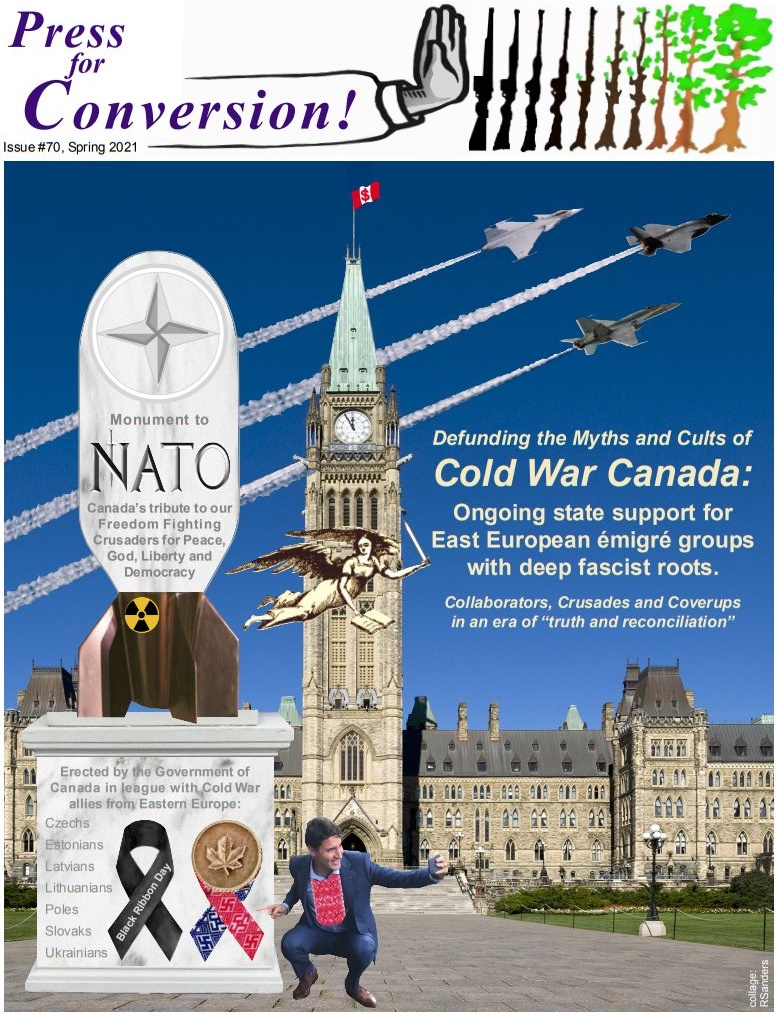 Defunding the Myths and Cults of
Defunding the Myths and Cults of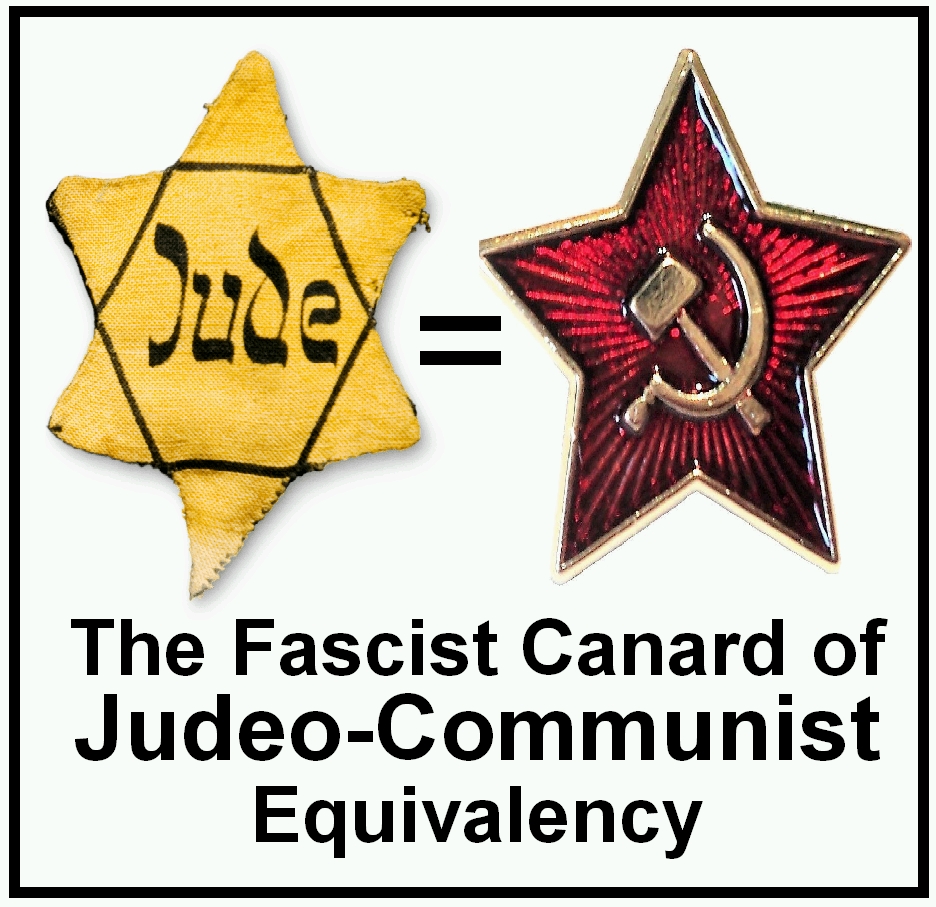 These
émigrés came from communities that had enthusiastically welcomed the Nazis
as liberators during Germany's massive June-1941 "Operation-Barbarossa"
invasion of the Soviet Union. Within a few years, Germany's attack and
occupation, assisted by local collaborators, had taken the lives of about
27 million Soviet citizens. Many of Canada's new arrivals from Eastern
European had actively supported the Nazi cause by taking up arms against
their common enemy, the much-fabled Moscovite, Judeo-Bolshevik bogeyman.
Later, when Canada's military ally—the Soviet Red-Army—was successfully
defeating the Wehrmacht invaders and chasing them back to Berlin,
hundreds of thousands of East Europeans chose to flee their ancestral
homelands to find safe haven in Nazi Germany.
These
émigrés came from communities that had enthusiastically welcomed the Nazis
as liberators during Germany's massive June-1941 "Operation-Barbarossa"
invasion of the Soviet Union. Within a few years, Germany's attack and
occupation, assisted by local collaborators, had taken the lives of about
27 million Soviet citizens. Many of Canada's new arrivals from Eastern
European had actively supported the Nazi cause by taking up arms against
their common enemy, the much-fabled Moscovite, Judeo-Bolshevik bogeyman.
Later, when Canada's military ally—the Soviet Red-Army—was successfully
defeating the Wehrmacht invaders and chasing them back to Berlin,
hundreds of thousands of East Europeans chose to flee their ancestral
homelands to find safe haven in Nazi Germany. 


